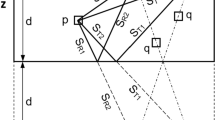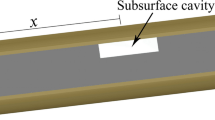Abstract
Glass epoxy jackets are commonly used to reinforce concrete bridge collars. Air voids in the bonding materials will degrade the mechanical strength of the glass epoxy reinforced collars. In order to detect air voids between a bridge collar and a glass-epoxy jacket, a focused microwave imaging system has been designed and implemented. An algorithm for inverting the dielectric constants from the measured electromagnetic signals was developed to image the size and location of the air voids. The developed microwave system operates at 10 GHz with one transmitter and one receiver. To increase the spatial resolution, dielectric lenses were used to focus the microwave beam from antennas. In the measurement, the sensor system was mechanically turned around the concrete collar with glass epoxy jackets. Two-dimensional signals were measured at 2-degree intervals. The dielectric constant distribution over the bonding layer was then obtained by inverting the two-dimensional signals. A lab sample of composite jacket was prepared with known air voids to verify the developed system. The inverted distribution of the dielectric constants over the bonding layer agreed very well with the actual distribution of the disbonds in both positions and sizes. In this paper, we present the details of the inversion theory and also the hardware system.
Similar content being viewed by others
References
Erdik, M. (ed.), 2001, Strong Motion Instrumentation for Civil Engineering Structures, Kluwer Academic Publishers.
Feng, M.Q., Liu, C., He, Xi., and Shinozuka, M., 2000, Electromagnetic image reconstruction for damage detection: Journal of Engineering Mechanics, p. 725-729.
Zoughi, R. and Bakhiari, S., 1990, Microwave nondestructive detection and evaluation of disbonding and delamination in layered-dielectric-slabs: IEEE Trans. Instrumentation and Measurement, v. IM-39, p. 1059-1063.
Bakhiari, S., Qaddoumi, N., Ganchev, S.I., and Zoughi, R., 1994, Microwave noncontact examination of disbond and thickness variation in stratified composite media: IEEE Trans. Microwave Theory and Tech., v. MTT-42, p. 389-395.
Ganchev, S.I., Qaddoumi, N., Ranu, E., and Zoughi, R., 1995, Microwave detection optimization of disbond in layered dielectrics with varying thickness: IEEE Trans. Instrumentation and Measurement, v. IM-44, p. 326-328.
Lo, Y.T. and Lee, S.W., 1998, Antenna Handbook: Theory, Application, and Design, Van Nostrand Reinhold, New York.
Chew, W.C., 1990, Waves and Fields in Inhomogeneous Media, Van Nostrand Reinhold, New York.
Author information
Authors and Affiliations
Rights and permissions
About this article
Cite this article
Li, J., Liu, C. Noncontact Detection of Air Voids Under Glass Epoxy Jackets Using a Microwave System. Subsurface Sensing Technologies and Applications 2, 411–423 (2001). https://doi.org/10.1023/A:1013221118462
Issue Date:
DOI: https://doi.org/10.1023/A:1013221118462




